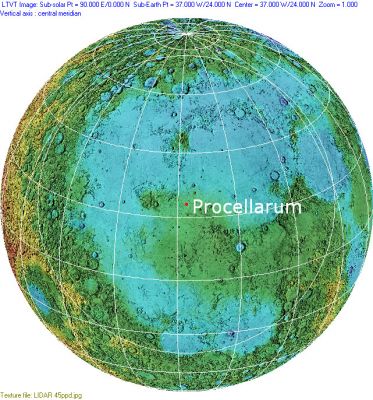Gargantuan basin
Contents
Procellarum Basin
(also known as Gargantuan Basin; both names unofficial)| Lat: 23°N, Long: 15°W, Main ring diam: 3200 km, Depth: km, Rukl: |
Clementine LIDAR data: altitude-coded shaded relief map. Note: the impact basin database gave only a diameter for this feature, and therefore the center position is shown incorrectly in this image -- according to Whitaker the center should be about 20 degrees farther to the east.
Images
Maps
(LAC zone most of nearside) USGS Digital Atlas
Basin Classification
(description of terms and most numeric basin data from Wood, C.A. (2004) Impact Basin Database)
| Certainty of Existence |
USGS Age |
Wilhelms Age Group |
Ring Diameters |
Mare Thickness |
Mascon |
| Uncertain |
Pre-Nectarian |
1 |
3200 km |
1 km |
Description
The Procellarum Basin is a putative very ancient and very huge impact basin on the Moon's nearside. Its existence was proposed by Cadogan in 1974, with further contributions by Whitaker in 1981. Although its existence is still regarded as uncertain by many, it is a major player in Wilhelms' Geologic History of the Moon, where it is regarded as the oldest still recognizable large impact basin on the Moon. - Jim Mosher
Additional Information
- P. H. Schultz has been particularly vocal in expressing doubts about the existence of the Procellarum Basin. In his 1995 article he suggests that the tell-tale rings that were used as evidence of its existence are instead much later formations and the expected consequences of an oblique impact forming the Imbrium Basin. - Jim Mosher
Nomenclature
- Cadogan proposed the name "Gargantuan Basin". However Whitaker noted that basins enclosing maria are normally named for the mare they contain. Hence, since the mare of Oceanus Procellarum had not been assigned an impact basin, he proposed the less colorful name "Procellarum Basin", which seems to be more widely used of the two names. Like all basin names, these are informal, and not part of the IAU nomenclature.
- Is this the same as Charles J. Byrne's Near Side Megabasin? (see his book The Far Side of the Moon, A Photographic Guide) (Springer, 2008).
LPOD Articles
Bibliography
- Cadogan, P. H. (1974). Oldest and largest lunar basin?. Nature, Volume 250, Issue 5464, pp. 315-316.
- Whitaker, E. A. (1981). The lunar Procellarum basin. In: Multi-ring basins: Formation and evolution; Proceedings of the Lunar and Planetary Science Conference, Houston, TX, November 10-12, 1980. (A82-39033 19-91) New York and Oxford, Pergamon Press, 1981, p. 105-111.
- Spudis, P. D. and Schultz, P. H. (1985). The Proposed Lunar Procellarum Basin: Some Geochemical Inconsistences
- Schultz, P. H. (1995). Making the Man in the Moon: Origin of the Imbrium Basin. Abstracts of the Lunar and Planetary Science Conference, volume 26, pp. 1251-2.
